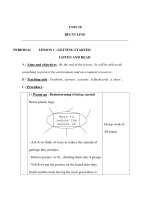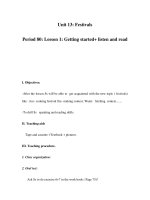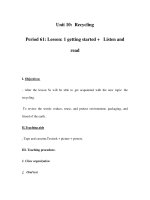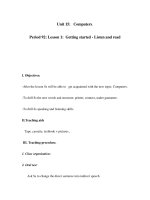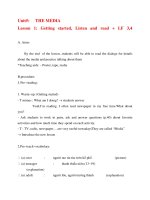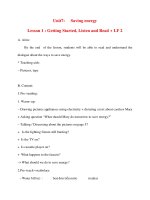Unit 10 Sources of Energy Lesson 1 Getting started
Bạn đang xem bản rút gọn của tài liệu. Xem và tải ngay bản đầy đủ của tài liệu tại đây (656.03 KB, 20 trang )
<span class='text_page_counter'>(1)</span>Hai Boi Secondary School. WELCOME TO OUR CLASS TODAY Subject: English 7 Teacher: Nhu Thi Toan Nang.
<span class='text_page_counter'>(2)</span>
<span class='text_page_counter'>(3)</span> What types of energy do you know?. ENERGY.
<span class='text_page_counter'>(4)</span> oil. gas. coal. solar. electricity. Energy. wind. Nuclear. hydro Natural gas. Water.
<span class='text_page_counter'>(5)</span> Friday, March 3rd , 2017 Period 84 - Lesson 1: Getting started (P 38, 39).
<span class='text_page_counter'>(6)</span> Friday, February 28th, 2017 Unit 10 : SOURSES OF ENERGY Period 84 – Lesson 1: Getting started (P. 38, 39 ). I. New words: 1. carbon footprint (n) /ˌkɑːbən ˈfʊtprɪnt/: dấu chân các-bon 2. carbon dioxide (n) /ˌkɑːbən daɪˈɒksaɪd/: khí CO2 3. negative (adj) / 'neɡətɪv/: xấu, tiêu cực 4. renewable (adj) /ri'nju:əbl/: có thể phục hồi 5. biogas (n) /'baiou,gæs/: khí sinh học 6. run out (n): cạn kiệt 7. use up (v): dùng hết 8. hydro (n) /'haidrou /: thuộc về nước.
<span class='text_page_counter'>(7)</span> * Dấu chân carbon” là gì? (What is carbon footprint ? ) Tác động của bạn đến môi trường mạnh đến cỡ nào, những hành động thường nhật của bạn thải thêm vào khí quyển bao nhiêu khí carbonic (CO2); tất cả những số liệu đó sẽ được tính toán đo lường và hiển thị bằng một con số mà chúng ta gọi là carbon footprint – dấu chân carbon. Con số của bạn càng lớn thì tác động xấu của bạn đến môi trường càng mạnh, tựa như một dấu chân khổng lồ in lên bề mặt trái đất vậy. Theo như lý tưởng mà nói, thì khi một người nhìn thấy con số dấu chân carbon của mình và nhận ra cách sống của họ ảnh hưởng đến trái đất nhiều đến mức nào, họ sẽ bắt đầu thực hiện những thay đổi để giảm số dấu chân carbon của mình..
<span class='text_page_counter'>(8)</span> * Matching:. Carbon footprint hydro biogas use up run out negative non-renewable carbon dioxide. khí sinh học cạn kiệt xấu, tiêu cực dấu chân các bon các bon điôxít dùng đến hết nước không thể phục hồi.
<span class='text_page_counter'>(9)</span> True or false 1.Carbon footprint is in the news a lot these days 2. It’s better to have a bigger footprint 3. Non –renewable energy sources like coal , natural gas ,and oil . 4. Mai thinks , she has a big carbon footprint. T F.
<span class='text_page_counter'>(10)</span> II. Reading: Mai: Nam, I read yesterday that we all have carbon footprint. Nam: Well, we all have footprints- we make them with our feet. Mai: Ha ha, I know that. But this kind of footprint is about the negative effect we have on the environment. Nam: Right, it’s in the news a lot these days. Mai: So our footprint is bigger when we use energy that produces carbon dioxide. That’s bad for the environment. Nam: So it’s better to have a smaller footprint, right? Mai:Right,Nam.Non-renewable energy sources like coal,natural gas,and oil produce a lot of carbon dioxide.Those sources are going to run out soon too Nam: So, they are different to wind, hydro, and solar? Mai: Yes, they’re all sources of energy too, but they’re renewable. That means we can’t use them all up – they will last forever. Nam: Do you have a big carbon footprint, Mai? Mai: Mine’s small. I recycle the products I use and I go everywhere by bike. We have solar panels on our roof at home to catch the sun’s energy, too. Nam: Oh no! I think my footprint is big, and not just because of these big shoes!.
<span class='text_page_counter'>(11)</span> True or false 1.Carbon footprint is in the news a lot these days. T F . 2. It’s better to have asmaller bigger footprint 3. Non –renewable energy sources like coal , natural gas ,and oil . small 4. Mai thinks , she has a big carbon. footprint. .
<span class='text_page_counter'>(12)</span> II. Reading: Mai: Nam, I read yesterday that we all have carbon footprint. Nam: Well, we all have footprints- we make them with our feet. Mai: Ha ha, I know that. But this kind of footprint is about the negative effect we have on the environment. Nam: Right, it’s in the news a lot these days. Mai: So our footprint is bigger when we use energy that produces carbon dioxide. That’s bad for the environment. Nam: So it’s better to have a smaller footprint, right? Mai:Right,Nam.Non-renewable energy sources like coal,natural gas,and oil produce a lot of carbon dioxide.Those sources are going to run out soon too Nam: So, they are different to wind, hydro, and solar? Mai: Yes, they’re all sources of energy too, but they’re renewable. That means we can’t use them all up – they will last forever. Nam: Do you have a big carbon footprint, Mai? Mai: Mine’s small. I recycle the products I use and I go everywhere by bike. We have solar panels on our roof at home to catch the sun’s energy, too. Nam: Oh no! I think my footprint is big, and not just because of these big shoes!.
<span class='text_page_counter'>(13)</span> a. Answer the following questions. 1.. What is a carbon footprint ?. It’s about the negative effect we have on the environment.. 2.. What does ‘non renewable energy’ mean ?. ‘Non –renewable energy’ means that it will run out if we use it. 3.. Why is sunlight a renewable resource ?. Sunlight is a renewable energy because we can’t use it all up , it will last forever. 4. Why does Mai think she has a small carbon footprint ? Because she recycles the products she uses and she goes everywhere by bike 5. What things do you think might create a big carbon footprint ? The products we use that are bad for the environment or the energy we use that product carbon dioxide might create a big carbon footprint.
<span class='text_page_counter'>(14)</span> b. Complete the network below using information from the conversation .. Sources of energy Renewable sources. Non -renewable sources.
<span class='text_page_counter'>(15)</span> b. Complete the network below using information from the conversation .. Sources of energy Renewable sources. wind. hydr o. solar. Non -renewable sources. sources. Natural gas. oil.
<span class='text_page_counter'>(16)</span> 2. Now, listen and repeat the words and phrase Wind. coal. Natural gas. nuclear. biogas. oil. Hydro. solar.
<span class='text_page_counter'>(17)</span> Complete the table below using information from the conversation: Renewable. Non-renewable.
<span class='text_page_counter'>(18)</span> Answer key: Renewable sources. Non- renewable sources. Example : wind. Example: coal. hydro , biogas ,. Natural gas , oil. nuclear, solar.
<span class='text_page_counter'>(19)</span> III. Practice: Ask and answer the questions about renewable and nonrenewable resources:. A: What type of energy source is wind ? B: It’s a renewable source of energy . A: What type of energy source is coal ? B: It’s a non-renewable source of energy ..
<span class='text_page_counter'>(20)</span> - Practice the dialogue, learn by heart vocabulary. - Do the exercises in the work book B1. - Prepare the new lesson: Unit :10 Lesson 2: A closer look 1.
<span class='text_page_counter'>(21)</span>
